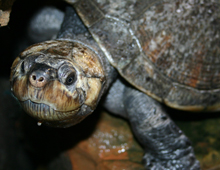Description: The Madagascar big-headed turtle gets its name from the size of its head. Most turtles are able to retract their head all the way into the shell, but due to the size of the head, it cannot be retracted completely. For this reason, it has developed rigid scutes on the top and sides of the head. The shell is hard and dark brown and the neck is long.
Size: Erymnochelys madagascariensis is an average sized turtle, usually reaching lengths of 17-20 inches (43-50 cm).
Behavior: This turtle is highly aquatic but ventures on land to lay eggs; basks on logs, rocks or banks surrounded by water.
Diet: This mainly herbivorous turtle eats plants, fruits, flowers and leaves of plants hanging over the water, but occasionally it will eat small vertebrates.
Senses: This species is not adept at hearing, but has excellent sight and smell.
Communication: Turtles are predominantly solitary animals, so little is known about their communication. They do, however, use physical communication when breeding season approaches. The male will typically bob his head and the bite the females leg to attract her to mate.
Reproduction: After mating in the water, the female comes ashore to lay her eggs. She lays 10- 25 leathers, textured elongated eggs.
Habitat/range: They are found only in the slow flowing rivers and swamps on the island of Madagascar.
Status: Listed by IUCN as Critically Endangered; Appendix II of CITES. It is a sought after food item in its native country.



